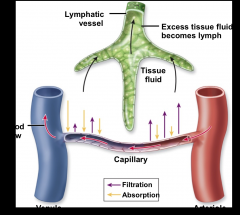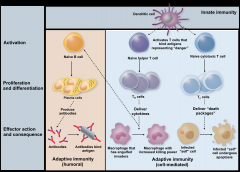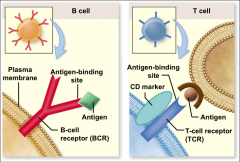![]()
![]()
![]()
Use LEFT and RIGHT arrow keys to navigate between flashcards;
Use UP and DOWN arrow keys to flip the card;
H to show hint;
A reads text to speech;
132 Cards in this Set
- Front
- Back
|
To microbes, human body is |
nutrient-rich |
|
|
blood,muscles, bones, organs are generally |
sterile |
|
|
these 2 prevent entry |
Skin,mucous membranes |
|
|
routine protection is provided by |
Innate immunity |
|
|
describe Innate immunity |
Althoughconsidered non-specific, involves pattern recognition of specific molecules |
|
|
•Adaptiveimmunity |
–Developsthroughout life –Antigenscause response –Producesantibodies tobind |
|
|
Overviewof Innate Defense |
See PIC |
|
|
First-Line Defenses (4 of them) |
Skin •Mucous Membranes •Antimicrobial Substances •Normal Microbiota (Flora) |
|
|
–Difficult for microbes to penetrate |
Skin |
|
|
•Mucous Membranes are found where? |
–Digestive, respiratory, genitol urinary tractsConstantly bathed in secretions (e.g.,mucous ) |
|
|
•Antimicrobial Substances( 6 of them) |
–Protect skin, mucous membranes –Salt accumulates from perspiration –Lysozyme degrades peptidoglycan –Peroxidase enzymes break down hydrogen peroxide –Lactoferrin binds iron –Defensins form pores in microbial membranes |
|
|
•Normal Microbiota (Flora) do what |
–Competitive exclusion of pathogens –Production of toxic compounds –Disruption of normal microbiota(e.g., antibiotic use) can predispose person to infections |
|
|
Give example of Production of toxic compounds |
•Propioni bacterium degrade lipids, produce fatty acids |
|
|
give example of Disruption ofnormal microbiota |
•Clostridium difficile in intestine |
|
|
Process for formation of Cells that comprise the immune system |
development termed hematopoiesis |
|
|
Blood cells originate from |
–from hematopoietic stem cells•Found in bone marrow |
|
|
Blood cells are found |
–Moveing around body, travel throughcirculatory systems –Always found in normal blood•Numbers increase during infections –Some reside in various tissues |
|
|
what are the 4 types of Leukocytes (White blood cells) in the Immune System |
Granulocytes MononuclearPhagocytes DendriticCells Lymphocytes |
|
|
Granulocytes contain |
cytoplasmic granules |
|
|
3 types of Granulocytes |
Neutrophils Basophils Eosinophils |
|
|
Neutrophils do what |
•engulf and destroy bacteria, othermaterial |
|
|
Basophils do what |
•involved in allergic reactions,inflammation |
|
|
Eosinophils do what |
•fight parasitic worms –Also involved in allergic reactions |
|
|
–MononuclearPhagocytes do what |
•Includes monocytes (circulate in blood)and cell types that develop as they leave blood stream |
|
|
–Dendritic Cells |
•Sentinel cells, function as “scouts” •Engulf material in tissues, bring it tocells of adaptive immune system for “inspection” |
|
|
Lymphocytes |
•Responsible for adaptiveimmunity •B cells, T cells highly specific inrecognition of antigen –Generally reside in lymph nodes,lymphatic tissues •Natural killer (NK) cells lackspecificity |
|
|
•Communication allows coordinated response via |
Surface receptors Adhesion molecules Cytokines |
|
|
Surface receptors serve as |
–“eyes” and “ears” of cell •Usually span membrane, connect outside to inside •Binding to specific ligand induces response |
|
|
Adhesion molecules |
–molecules allow cells to adhere to other cells
•E.g., endothelial cells can adhere to phagocytic cells, allow them to exit bloodstream |
|
|
Cytokines are |
–“voices” of cell •Produced by cell, diffuse to others, bindto appropriate cytokine receptors to induce changes such as growth,differentiation, movement, cell death |
|
|
Multiple types of cytokines are used in the immune system ( 5 of them) |
•Chemokines •Colony-stimulating factors (CSFs) •Interferons (IFNs) •Interleukins (Ils) •Tumor necrosis factor (TNF) |
|
|
•Chemokines do what |
–chemotaxisof immune cells |
|
|
•Colony-stimulating factors (CSFs)do what |
–multiplication and differentiation of leukocytes |
|
|
•Interferons (IFNs) do what |
–control of viral infections, regulation of inflammatory response |
|
|
•Interleukins (Ils) do what |
– produced by leukocytes; important in innate and adaptive immunity |
|
|
•Tumor necrosis factor (TNF)do what |
–inflammation, apoptosis |
|
|
Our immune systems needs to detect foreign invaders |
•Uses receptor proteins that detect pathogen proteins or signals
•Pattern recognition receptors (PRRs) |
|
|
•Pattern recognition receptors (PRRs) do what |
–detect pathogen-associated molecular patterns(PAMPs), “see” signs of microbial invasion
–Cell wall components (LPS), flagellar subunits,viral RNA molecules |
|
|
Cell wall components (LPS) 3 types |
•Toll-like receptors (TLRs) anchored in membranes of sentinel cells •NOD-like receptors (NLRs) found in cytoplasm–Cell damage •RIG-like receptors (RLRs) found in cytoplasm–viruses |
|
|
The complement system helps to activate the immune system |
Proteins circulating in blood and bathing tissues •Proteins named in order discovered•C1 throughC9
•Activated by three different pathways |
|
|
What are the 3 different pathways of the complement system |
Alternative pathway Lectin pathway Classical pathway |
|
|
Alternative pathway is |
•triggered when C3b binds to foreign cell |
|
|
Lectin pathway is |
triggered when pattern recognition molecules bind to mannose |
|
|
Classical pathway |
•activated by antibodies bound to antigen |
|
|
See pic for all 3 alternative pathways |
|
|
|
Activation of the complement results in three major outcomes |
Opsonization
Inflammatory Response Lysis of Foreign Cells |
|
|
Opsonization |
•C3b binds to bacterial cells and foreign particles, allows phagocytes to engulf more easily |
|
|
Inflammatory Response |
•C5a attracts phagocytes to area; C3a andC5a increase permeability of blood vessels, induces release cytokines |
|
|
Lysis of Foreign Cells |
•proteins C5b,C6, C7, C8, and C9 molecules assembling in cell membranes of Gram negatives |
|
|
Phagocytes do what |
engulf and destroy pathogens |
|
|
Phagocytes are |
recruited by the complement and engulf cells surrounded by C3b
Once inside the cell, the pathogen is destroyed using radical oxygen species and enzymes |
|
|
The process of phagocytosis |
1. Chemotaxis 2. recognition and attachment 3.Engulfment 4. phagosome maturation and phagolysosome formation 5. Destruction and digestion 6.Exocytosis |
|
|
Macrophages play what role in what system? |
sentinels that can help activate the complement |
|
|
Macrophages will do what |
•scavenge throughout the body destroying dead cells or pathogens that they encounter
•Will produce cytokines in response to detecting or destroying a pathogen |
|
|
Neutrophils act as |
•rapid response team: move into area and eliminate invaders |
|
|
Neutrophils play a critical role in |
•early stages of inflammation •First to be recruited from blood stream to site of damage •More powerful than macrophages, but shortlife span •Kill microbes via phagocytosis |
|
|
The Inflammatory Response results in what? |
•Tissue damage results in inflammation |
|
|
Tissue damage results in inflammation purpose is |
–to contain site of damage, localize response, eliminate invader, and restore tissue function |
|
|
In the Inflammatory Response |
–Pattern recognition receptors (TLRs, NLRs) trigger •Detect PAMPsetc. •Host cells release inflammatory mediators–cytokines |
|
|
Inflammatory process involves cascade of events which are ( 6 of them ) |
–Dilation of small blood vessels –Migration of leukocytes from bloodstream to tissues –Clotting factors wall off site of infection –Dead neutrophils, tissue debris accumulate as pus –Acute inflammation is short term; macrophages clean up damage by ingesting dead cells and debris –If acute fails, chronic inflammation results; macrophages, giant cells accumulate, and granulomas form (clumps of macrophages)•Attempt to separate area |
|
|
The Inflammatory Response |
See pic |
|
|
Fever is |
•important host defense mechanism |
|
|
Describe Fever |
–Temperature-regulation center in brain normally holds at 37°C but raises during infection in response to pyrogens •Cytokines produced by macrophages following detection of microbial products •Exogenous pyrogens produced by microbes –Growth rates of bacteria optimized for 37°C typically drop sharply above optimum, allows more time for defenses |
|
|
Adaptive Immunity Develops |
Throughout Life |
|
|
Adaptive Immunity Develops is |
•most effective means to eliminate invader
|
|
|
Adaptive Immunity Develops had 5 points |
–Takes a week or more to build following first exposure –Innate immunity must protect during this time –Adaptive immunity has memory•Stronger response to re-exposure –Vaccination relies upon this ability –Must distinguish between “healthy self” and “dangerous” (called nonself recognition) Recognizes antigens |
|
|
What is an antigen? Antigen comes from |
antibody generator |
|
|
Define Antigen |
–Describes a molecule that reacts specifically with antibody, (a B-cell receptor, or a T-cell receptor) •Antigen that elicits immune response called an immunogen
–Enormous variety of antigens (e.g., microbes, pollen) |
|
|
Antigen Pic |

|
|
|
Where do the cells in the adaptive immune system reside? |
•in Lymphatic system |
|
|
•Lymphatic system is collection of tissues and organs. this does what |
–Brings population of B cells and T cells into contact with antigens |
|
|
Lymphatic vessels (lymphatics) do what |
carry lymph
–Fluid from body’s circulatory system filters out, not all returns to capillaries; enters lymphatics instead •Contains white blood cells and antigens from tissues •Returns to lymph nodes; proteins, cells,other materials are removed •Lymph then empties back into circulatory system •Inflammatory response causes more fluid to enter tissues; increases antigen-containing fluids entering lymphatic system |
|
|
Lymphatic system PIC |

|
|
|
Anatomy of the Lymphatic System |
•Primary lymphoid organs include bone, thymus •Secondary Lymphoid Organs |
|
|
•Primary lymphoid organs include bone, thymus |
–Hematopoietic stem cells reside in bone marrow; give rise to all blood cells including lymphocytes |
|
|
•Secondary Lymphoid Organs |
–Sites where lymphocytes gather to contact antigens •Lymphnodes, spleen, tonsils, adenoids, appendix |
|
|
First response to antigen is |
primary response |
|
|
describe primary response |
–Adaptive immune system “remembers”mechanism that proved effective against that specific antigen •If encountered again, a stronger secondaryresponse results |
|
|
–Two basic strategies for countering foreign materials |
•Humoral immunity works to eliminate extracellular antigens –Bacteria, toxins, viruses in bloodstream, tissue fluids
•Cell-mediated immunity (CMI)/cellular immunity deals with antigens residing within a host cell–E.g., invading virus infecting cell |
|
|
Humoral Immunity is composed of |
–B lymphocytes or B cells are responsible
|
|
|
B lymphocytes or B cells develop in |
–bone marrow |
|
|
B lymphocytes or B cells are triggered |
–to proliferate, differentiate into plasma cells in response to extracellular antigens |
|
|
Triggered B lymphocytes or B cells |
•Produce antibodies •Bind to antigens with high degree ofspecificity•Many different antibodies needed for wide array of antigens •Some B cells form long-lived memory B cells –Respond quickly if antigen encountered again |
|
|
Cell-Mediated Immunity is composed of |
–T lymphocytes (T cells) |
|
|
–T lymphocytes(T cells) mature in |
thymus |
|
|
Two subsets of cell mediated immunity |
•CytotoxicT cells and helper T cells
•Both have multiple surface copies of T-cell receptor |
|
|
CytotoxicT-cells versus Helper T-cells |
|
|
|
T-cells are activated by |
•dendritic cells upon detection of an invader
•Once activated, T cell proliferates and differentiates into either cytotoxic (TC) or helper (TH) |
|
|
cytotoxic (TC) and helper (TH) can |
form memory cells |
|
|
TC cells |
respond to intracellular antigens, induce cell to undergo apoptosis (e.g., virally infected cell) |
|
|
TH cells |
•help orchestrate humoral and cell-mediated immunity (activate B cells, macrophages; produce cytokines) |
|
|
Overview of the Adaptive Immune System |

|
|
|
Receptors in the Adaptive Immune System |
•Lymphocyte Receptors |
|
|
who has Lymphocyte Receptors and what do they do? |
–B cells and T cells have membrane-bound receptors –Function to recognize specific antigens •BCR is specific antibody the B cell is programmed to make •TCR does not recognize free antigen; must be presented by body’s own cells |
|

|
See pic |
|
|
What are antibodies |
–immunoglobulins; –Y-shaped proteins with two general parts |
|
|
(Fab regions) |
bind antigen |
|
|
•(Fc region) |
Stem |
|

|
See pic |
|
|
Antibodies have two copies |
heavychain and light chain |
|
|
Light chains have |
– two domains; |
|
|
heavy chains have |
–usually four |
|
|
Fork of Y is |
flexible hinge region which allows conformation changes |
|
|
Variable region is at |
–ends of Fab regions |
|
|
–Fab regions do what |
•Accounts for specificity •Antigen-binding site attaches to specific epitope •Fit precise but reversible |
|
|
Constant region includes |
–Fc and part of two Fab regions
•Allows immune system components to recognize otherwise diverse antibody molecules |
|
|
BE ABLE TO DRAW AN ANTIBODY!!!!!! |
see pic |
|
|
What do antibodies do? |
•bind to an antigen they offer protective functions to the body. |
|
|
antibodies do 5 THINGS |
Neutralization Opsonization –Activated the complement Immobilization and prevention of adherence Antibody-dependent cellular cytotoxicity |
|
|
Neutralization |
–prevents toxins, viruses from binding |
|
|
Opsonization |
–enhancement of phagocytosis |
|
|
Immobilization and prevention of adherence |
binding to bacterial flagella or piliinterferes |
|
|
Antibody-dependent cellular cytotoxicity: |
targets cell for destruction by natural killer (NK) cells |
|
|
Five major classes of antibodies |
–IgM, IgG,IgA, IgD, IgE |
|
|
Immunoglobulin |
–Have same basic monomeric structure –Each class has different constant region.of heavy chain –Some form multimers of basic monomeric structure –Each class has distinct functions and properties |
|
|
B-cell activation by |
T-dependent antigens |
|
|
B-cell receptor binds to |
–antigen; antigen is internalized via endocytosis and degraded into peptide fragments
|
|
|
b cell mediated endocyosed fragments |
•delivered to MHC class II molecules for inspection by THcells: antigen presentation •If T-cell receptor binds a fragment, Tcell activates B cell with cytokines, initiates clonal expansion (of B cells) •Initially called the Primary Response |
|
|
The Primary ResponseTakes |
–10–14 days for substantial antibody accumulation |
|
|
Primary Response Person may be sick |
–, possibly seriously so, although immune system is actively responding•Some activated B cells continue dividing, others differentiate to form antibody-secreting plasma cells –Additional exposure to antigen yields much faster secondary response |
|
|
Some B cells differentiate to form |
plasma cells |
|
|
plasma cells generate |
•antibodies •Undergo apoptosis after a few days •Activated B cells continue proliferating and differentiating in presence of antigen, so titer steadily increases • Some B cells differentiate into memory cells • Will retain in the memory of the antibody that worked the best |
|
|
The.Secondary Response compared to the primary |
–Significantly faster, more effective than primary
•Pathogens usually eliminated before causing harm |
|
|
•Vaccination exploits this natural phenomenon |
The Secondary Response |
|
|
what kind of cells does the secondary response have and what do they do? |
–Memory B cells responsible: greater numbers present •Antibodies coded by memory cells bind antigen effectively •When activated, some quickly become plasma cells, produce antibodies –Often IgG or IgA due to class switching •Proliferating B cells again undergo affinitybmaturation,generating even more effective antibodies; future exposures elicit an even stronger response |
|
|
Natural Killer Cells are |
•Anothergroup of cytolytic lymphocytes distinct from B-lymphocytes and T-lymphocytes (innate immune system) |
|
|
Natural Killer Cells participate in |
both innate immunity and adaptive immunity. |
|
|
Natural Killer Cells are designed to |
•kill certain mutant cells and virus-infected cells in one of two ways: |
|
|
NK cells kill cell |
to which antibody molecules have attached –cells lacking MHC-I molecules on their surface. |
|
|
NK cells are important in |
innate immunity because they are able to recognize infected cells, cancer cells, and stressed cells and kill them. |
|
|
NK cells will recognize cancer cells that are abnormal based on |
•differences in their cell surface. |
|
|
•Early clinical trials in 1980’s, NK cells |
–Rapidly lose aggressiveness and difficult to destroy solid tumors –2012– combination of IL stimulates NK cells to reduce tumor size in mice and inhumans. –Required pre-treatment however. |

